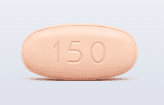Nirogacestat Dosage
Medically reviewed by Drugs.com. Last updated on Jul 8, 2024.
Applies to the following strengths: 50 mg; 100 mg; 150 mg
Usual Adult Dose for:
Additional dosage information:
Usual Adult Dose for Fibromatosis
150 mg orally twice a day
Duration of therapy: Until disease progression or unacceptable toxicity
Use: For the treatment of progressing desmoid tumors in patients who require systemic therapy
Renal Dose Adjustments
Renal dysfunction: Data not available
Liver Dose Adjustments
Dose Modifications for Elevated Liver Enzymes:
- Grade 2 increased ALT or AST (3 to 5 times the upper limit of normal [3 to 5 x ULN] or greater): Withhold therapy until ALT, AST, or both are resolved to less than 3 x ULN or baseline, and then restart therapy at 100 mg orally twice a day.
- Grade 3 or 4 increased ALT or AST (greater than 5 x ULN): Permanently discontinue
Dose Adjustments
DOSE MODIFICATIONS FOR ADVERSE REACTIONS:
Diarrhea:
- Grade 3 or 4 diarrhea persisting for at least 3 days despite maximal medical therapy: Withhold therapy until resolved to grade 1 or less, or baseline, and then restart therapy at 100 mg orally twice a day.
Hypophosphatemia:
- Grade 3 or 4 hypophosphatemia persisting for at least 3 days despite maximal replacement therapy: Withhold therapy until resolved to grade 1 or less, or baseline, and then restart therapy at 100 mg orally twice a day.
Hypokalemia:
- Grade 3 or 4 hypokalemia despite maximal replacement therapy: Withhold therapy until resolved to grade 1 or less, or baseline, and then restart therapy at 100 mg orally twice a day.
DOSE MODIFICATIONS FOR OTHER SEVERE, LIFE-THREATENING, OR PERSISTENT INTOLERABLE GRADE 2 ADVERSE EVENTS:
- Withhold therapy until resolved to grade 1 or less, or baseline.
- Only restart therapy at dose of 100 mg orally twice a day after considering the potential benefit and likelihood of recurrence of the adverse reaction.
- Permanently discontinue treatment for recurrence of a severe or life-threatening adverse reaction upon rechallenge at the reduced dose.
Precautions
CONTRAINDICATIONS: None
Safety and efficacy have not been established in patients younger than 18 years.
Consult WARNINGS section for additional precautions.
Dialysis
Hemodialysis: This drug is highly bound to plasma proteins and not expected to be dialyzable.
Peritoneal dialysis: Data not available
Other Comments
Administration advice:
- Administer each 150 mg dose of this drug as 3 tablets of 50 mg.
- Swallow each tablet whole; do not break, crush, or chew.
- This drug may be taken with or without food.
- If a dose is missed or vomited, instruct the patient to take the next dose at its scheduled time.
Storage requirements:
- Store at 20C to 25C (68F to 77F).
- Temperature excursions permitted between 15C to 30C (59F to 86F).
Monitoring:
- Dermatologic: For new non-melanoma skin cancers (at baseline and routinely during therapy)
- Endocrine: For signs and symptoms of ovarian toxicity
- Gastrointestinal: For severe diarrhea
- General: For drug interactions (regularly during therapy)
- Hepatic: Liver function tests (regularly during therapy)
- Metabolic: Phosphate and potassium levels (regularly during therapy)
Patient advice:
- Read the US FDA-approved patient labeling (Patient Information).
- Notify your health care provider if sustained diarrhea occurs that does not respond to supportive care.
- This drug may cause ovarian toxicity and impair fertility, potentially even after discontinuation of treatment; inform your health care provider of any symptoms of ovarian toxicity, including hot flashes or menstrual irregularities.
- This drug may elevate liver enzymes; your health care provider should monitor liver function regularly.
- Contact your health care provider if any new or changing lesions occur on the skin as this drug may cause new non-melanoma skin cancers.
- This drug can cause electrolyte abnormalities which may require phosphate and/or potassium supplementation; seek medical attention if any symptoms of muscle pain or weakness occur.
- Inform your health care provider of all concomitant medications, including over-the-counter drugs.
- Breastfeeding is not recommended during treatment.
- Patients of childbearing potential:
- This drug may cause potential harm to a fetus.
- Notify your health care provider of a known/suspected pregnancy; stop taking this drug if you become pregnant.
- Females and males (with female partners of reproductive potential): Use effective contraception during treatment and for 1 week after the last dose.
More about nirogacestat
- Check interactions
- Compare alternatives
- Side effects
- During pregnancy
- Drug class: miscellaneous antineoplastics
- En español
Patient resources
Other brands
Professional resources
Other brands
Related treatment guides
See also:
Further information
Always consult your healthcare provider to ensure the information displayed on this page applies to your personal circumstances.


